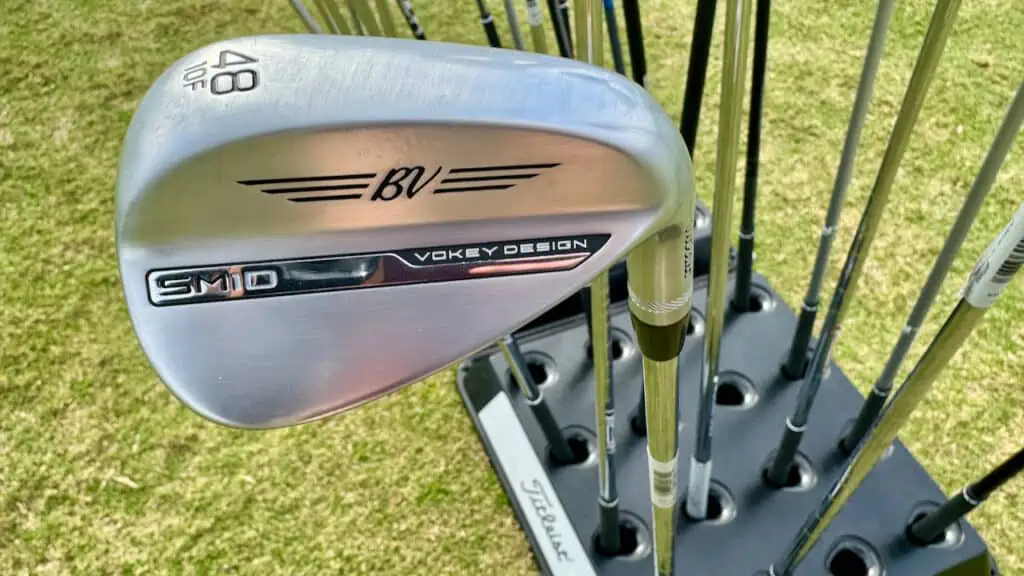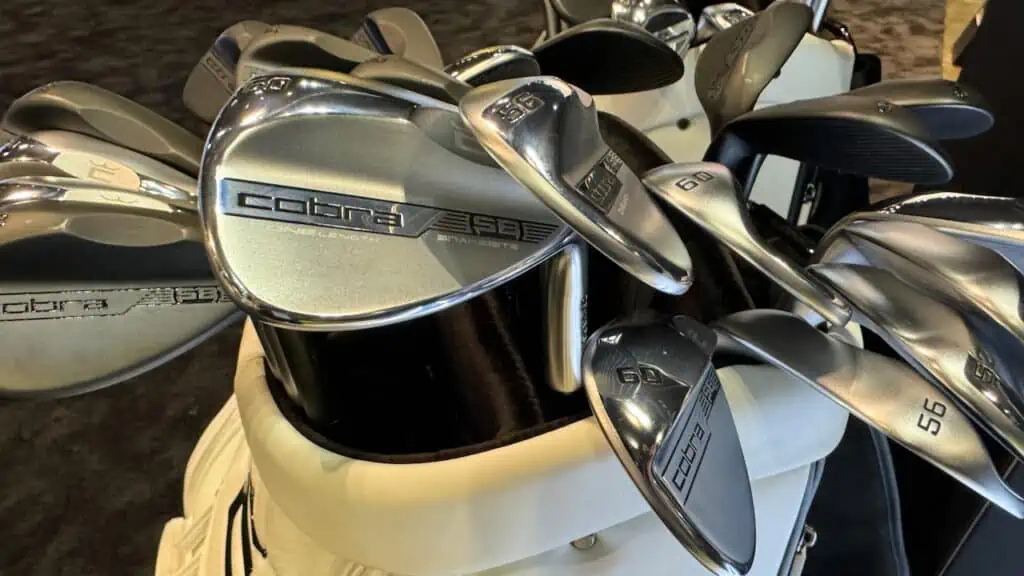Table of Contents
Chipping is easily one of the most challenging shots to master in golf. It calls for finesse in your swing, precision in delivery, imagination, and perhaps at times, even some guts.
It’s common to see golfers struggle with their short game owing to the expertise it demands. So, you maybe deciding between the chipper vs wedge for your own game. In this article, you’ll get an answer to what’s worked for us.
What is a golf chipper?

The chipper was invented in 1997 by Larry J. White. It simplifies green-side chipping in that you don’t need to stand in a chipping stance and make a chipping motion. Just address the ball the way you would a putt and make an exaggerated putting stroke.
A chipper is a golf club that combines elements of a iron and a putter. The club face has got the loft of a 7 iron, but the lie angle and shaft length are that of a putter.
This makes it easier for the golfer to hit chip shots allowing for better chest-to-grip control over the ball to loft it up more easily and efficiently. The design of a chipper allows you to hit otherwise delicate chip shots with relative ease.
Keep in mind, your stance is the same as when you are putting, which allows for more control and consistency around the greens.
Here’s a few top-rated golf chippers:
⛳️ Related: Our Favorite Golf Chippers on the Market
What Is a Golf Wedge?

A wedge is an essential club that’s part of the irons. They have high lofts and short shafts, along with heavy club heads. All these features help in hitting precision shots around the green or relatively close to it.
The primary aim while using a wedge is to loft the ball up in the air so it lands at a steeper angle and stops quickly, preferably with a backspin.
The sole of a wedge is also modified to allow the player to hit shots from a variety of spots, such as hazards, soft or tight lies, sand bunkers, muddy lies, etc.
4 Common Types of Golf Wedges

Golf wedges are generally classified into four kinds. Let’s discuss each.
| Club | Loft Angle | Distance to Green |
|---|---|---|
| Pitching Wedge | 45-48° | Approach shots (Outside 100 yards) |
| Gap Wedge | 48-54° | 100 yard shots |
| Sand Wedge | 54-58° | 50-100 yard shots |
| Lob Wedge | 58-62° | Less than 60-yard shots |
1. Pitching Wedge (45-48°)
A pitching wedge typically has between 45 and 48 degrees of loft. It’s used more or less like the rest of your irons.
A pitching wedge is primarily used for approach shots outside 100 yards, depending, of course, on individual yardages that vary from player to player.
Pitching Wedges are also used to hit a bump and run chip shots, owing to the lower loft and lower launch angle.
2. Gap Wedge (48-54°)
As the name indicates, gap wedges are used to fill the gap between pitching and sand wedges.
These are normally between 48 and 54 degrees of loft. It’s also known as the utility or approach wedge.
The gap wedge is usually used as the 100-yard club, i.e., to hit 100-yard shots. You can also use gap wedges to hit low-mid trajectory chip shots around the green.
3. Sand Wedge (54-58°)
Sand wedges are perhaps the single most essential wedge in golf. Many think it’s the best wedge out of the sand, although you can use a variety of golf clubs for the bunker.
These are usually between 54 and 58 degrees of loft.
A high bounce wedge is preferred from the sand to go through it more effectively. Average golfers usually hit use these between 50 and 100-yard shots, besides the bunkers and other hazards, of course.
4. Lob Wedge (58-62°)
Usually, the most lofted club in the bag, lob wedges, are between 58 and 62 degrees of loft.
The lob wedge can be your greatest weapon around the greens, allowing you to launch the golf ball almost vertically if required.
If there’s a tree or any other obstacle in close proximity between you and the green, or if you have to drop and stop the ball on a dime, the lob wedge should be your go-to.
The lob wedge is usually what Phil Mickelson uses for his famous flop shots. Here’s one of my favorite videos of Phil demonstrating for us.
If you are looking some of the best golf wedges on the market, I tend to prefer Cleveland and Titlest Vokey wedges, like the SM9, but our expert also recommends his top picks in our best golf wedges article.
Here’s a few top-rated golf wedges:
⛳️ Related: Our Favorite Wedges on the Market
Differences between the golf chipper vs wedge

Besides the obvious difference in appearance, here are some of the more player-specific differences when comparing the chipper vs wedge:
1. Shaft length
The average length of a chipper is around 36 inches, which is shorter than a mid or even short iron and more akin to the length of a putter.
This means more control for the player. Allowing you to make a more consistent strike and control your distance.
2. Lie angle
Where the lie angle of a wedge is quite apparent at set up, a chipper has got a straighter and more upright lie angle.
This makes it easier to set up the ball and make a putting-like stroke with the chipper.
3. Clubhead weight
The club head of a chipper is much heavier than that of a wedge, which has a blade-like shape.
This allows golfers to easily hit the chip shot without jerking their wrists and risking thinning or hitting it fat.
4. Ease of use
While the wedges ask a lot out of a player, the chipper is a Godsend.
You basically need to make the same putting stroke, and the ball is lifted up off the ground and rolling toward the hole.
5. Sole width
When compared to wedges, a chipper has got an extra-wide sole and an adjusted leading edge. This makes it almost impossible for a golfer to hit their chip shots chunky or fat.
The player doesn’t have to worry about stance, clubface position, rotation, etc. This immensely boosts confidence and results in better golf scramble or golf team tournaments.
Is a chipper as versatile as a wedge?
The simple answer is no. Although the chipper is a club of great importance (especially for high handicappers) the golf chipper serves a particular purpose and could do better from beyond the fringe/green side. Owing to its clubface design and loft, it can not hoist the ball beyond a specific loft.
On the flip side, a wedge can perform from many places like bunkers, hazards, and over obstacles such as trees. Besides that, wedges are essential for close-proximity approach shots that can’t be played with irons.
Statistically, about 65% of golf is played from within 100 yards of the hole. This is where wedges work their magic and save those precious strokes.
Are chippers legal in golf?
According to the USGA, chippers are a legal golf club, but there are certain conditions to adhere to when using them. These conditions include the following:
- Chippers cannot be used with a putting grip.
- Chippers must not have two striking faces, such as the Intel Two-Way Chipper
- The chipper must not have any appendages to be used for alignment.
- It must be the same length as, or shorter than, the length of a 7-iron.
Do pros use chippers?
Although using chippers is legal in competitive golf, it’s improbable that you’ll ever see a professional golfer using a chipper during match or championship play.
It is frowned upon by pros and amateurs of great ability because chippers are specially designed for mid or high-handicap golfers.
Chippers also allow far less control over spin. This is a significant problem for those who can stop the ball on a dime by imparting spin. So it would, in fact, be an impediment to a pro’s wedge game.
Who should use a chipper?

Golfers struggling with greenside chipping should consider using a chipper. If not as a permanent addition to your bag, it can help you build confidence around the greens and shave off a few strokes from your round.
Also, senior golfers who aren’t as flexible and agile should consider getting a chipper because of how easy it is to use.
Final Thoughts
When it comes to deciding bette a chipper vs wedge: golf wedges are no doubt the go-to option. In fact, most golfers carry on average 3 in their bag. The versatility of wedges, spin control, and shot-making ability cannot be overlooked.
Chippers are no doubt a brilliant invention and aid those that struggle with their short game. Those looking to improve their scrambling should consider investing in one.
Before you go…
Now that you have a good base for the difference between the chipper vs wedge, you’ll want to read our expert article on the short game tips.

